#nest parasites
Text
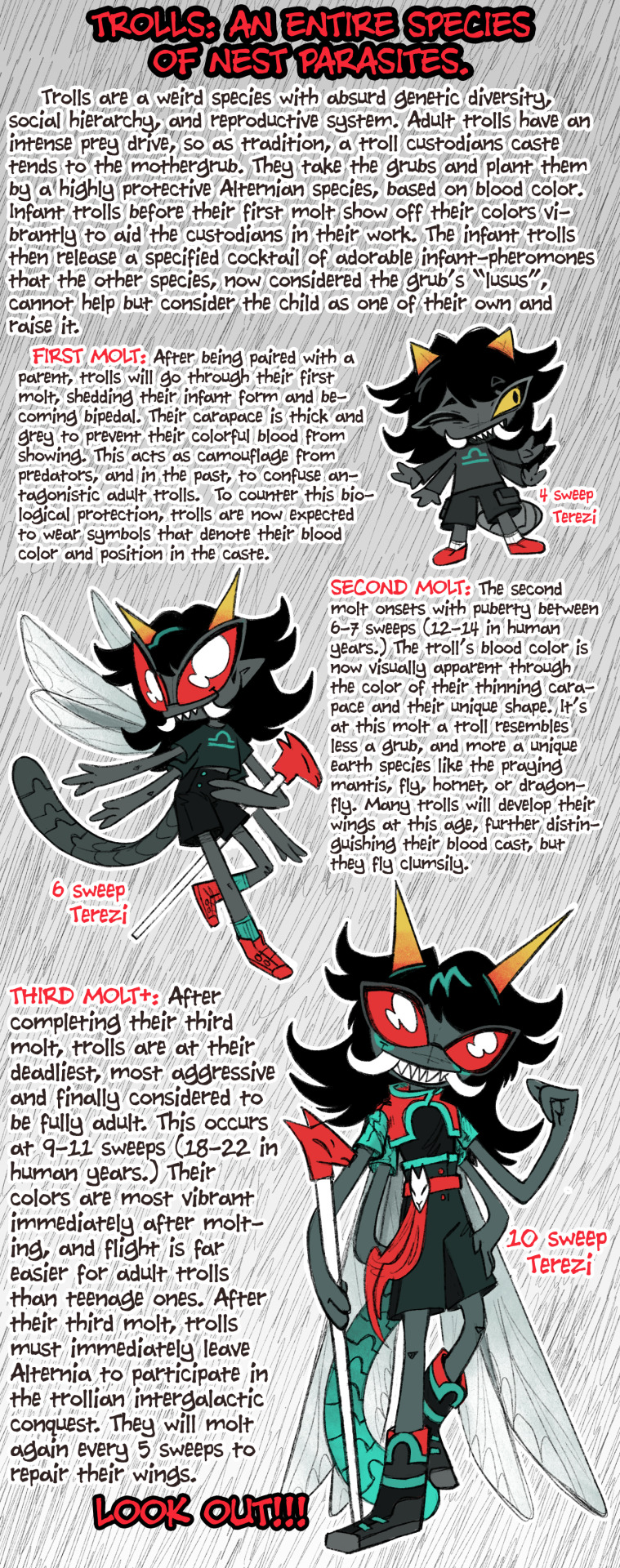
making up spec bio homestuck bug facts for fun!!
#trolls#terezi#homestuck#terezi pyrope#bugcore homestuck lore#bugstuck#SILLY BUG MOMENT#nest parasites#speculative biology#spec bio#tealblood#dragonfly
800 notes
·
View notes
Text


I had a big need for a fandom butterfly/moth display.
Updated with an ID: Art drawn to look like a Fictional Moth/Butterfly display case based on 4 characters from The Magnus Archives on a 8.5x11" print.
Big bug center top is labeled as "J. Sims": big green Luna Moth with multiple prominent eyes a bit like an Emperor Moth's markings, and holes in the wings that mimic the holes in a cassette tape. There's an eye on the mid of its body. The markings are more fantastical than the other bugs.
Labeled "M. Blackwood": Silver Clouded moth, smaller, to the right of J. Sims, with a cloudy looking pattern in greys on the wings, and two small dots.
Labeled "N. Sasha": Center-left. A blue butterfly but with markings that look like eyes and possibly claws extending across the top pair of wings. The wings are lined with black and white markings that resemble piano-keys. The lower pair of wings have golden markings that is supposed to resemble calliope pipes.
Labeled "Tim": Takes up the lower right side. A Mourning Cloak butterfly but with orange markings inside the wings that resemble flames. Mainly red wings lined with black then yellow edges, with blue spots across the black.
They are on a board with a spider web stretched across underneath them. The black tape of a cassette tape ribbons around the board in loose loops.
#the magnus archives#jonathan sims#martin blackwood#not sasha#timothy stoker#I'm so sorry Sasha#btw the Rebel's Large Blue butterfly caterpillar mimics ant queen sounds and smells so they are taken to the ant's nest as a brood parasite#moth fanart#tma as moths
722 notes
·
View notes
Text


YOU GOT IT LETS HEAR A ROUND OF APPLAUSE!!!!
#replies#EXACTLY LMAO#let's hear it for parasitic birds!!!#woo!! yeah! yee haw!!#and you know what some parent birds do when they find a parasitic bird in their nest?#they abandon the nest!#just because if they throw out the parasite itself#its likely that their parent will attack the nest later on#points at marinette dropping the classroom to try lone-wolfing
871 notes
·
View notes
Text
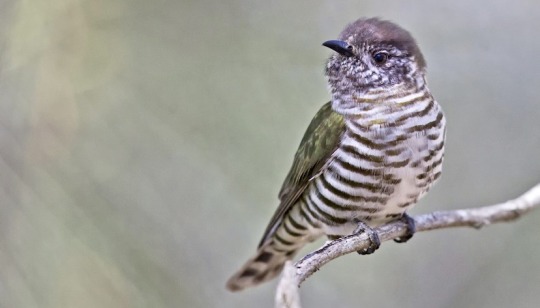

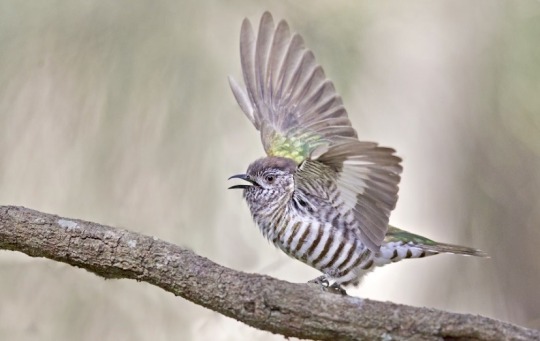


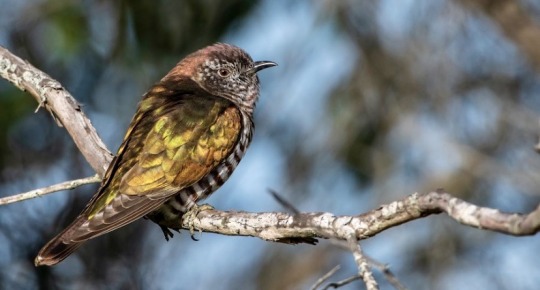

the shining-bronze cuckoo is a small cuckoo native to australia, new zealand, and surrounding islands. they primarily feed on insects caught in flight, with a preference for moths. the sexes are similar, but females’ heads and necks have a purple sheen and have deeper brown barring. these birds are nest parasites, and do not raise their own young. they lay a single egg in the nest of a host parent, removing one of the brood’s preexisting eggs. when the cuckoo chick hatches, it will displace other baby birds from the nest almost immediately, gaining the undivided attention and feeding from the host species. they commonly invade grey warbler nests; in one study, up to 55% of nests were taken over by shining-bronze cuckoos.
#shining-bronze cuckoo#cuckoo#bird#birblr#parasite#parasitism#parasitic#nest parasite#i need to go back and add the source but tumblr won’t let me link anything else rn 🫠 idk why
565 notes
·
View notes
Text
And now, some desert borbs.
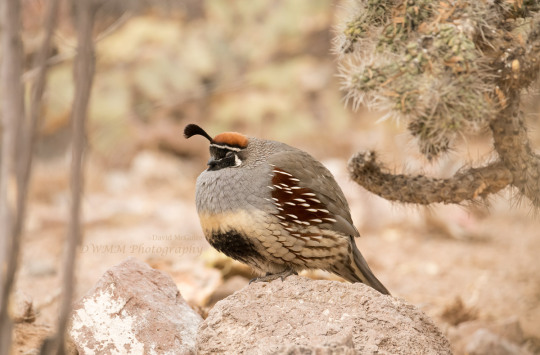
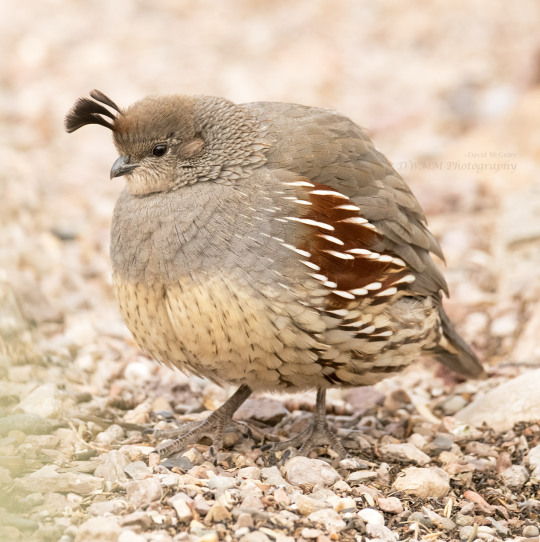
Gambel's quail.

And that most iconic of desert borbs (southwestern USA), the greater roadrunner.
#borb#bird#bird photography#gambel's quail#quail#greater roadrunner#roadrunner#bosque del apache#national wildlife refuge#abqbiopark#roadrunners are cuckoos#but not nest parasitic cuckoos#new mexico birds
217 notes
·
View notes
Text

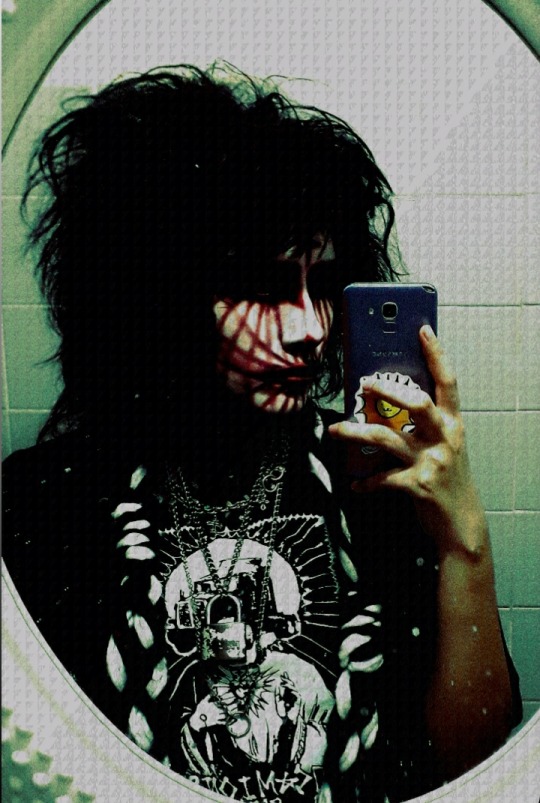


red era 💉🩸
#the parasite#my face#goth#corpse paint#trad goth#...sorta#went to see the night creepers with the besties and now im an instant fan#cant wait to go see them live again#ignore how awful my bat nest is on this photos#also i finally ran out of my black liner so i'm forcing myself to use all my other makeup and i wont buy anything new#until i finish all i have#this was friday's fit#i also designed this shirt for a local band yipee
22 notes
·
View notes
Text
i kind of love barry. autistic king
#scavengers reign#scavengers reign spoilers#(in the tags)#okay so sam didn't die but the following events were Much more interesting#the parasite creating compulsions? so cool#i would have loved to see an example done with a local fauna#but i can imagine it works similarly. compelled to build a nest etc etc#also terrence's death was so brutal but i Loved the visuals and sound for the quick snapping and twisting of the plant#carnivorous plant!! yayy!!!#very cool death#but yeah barry. i enjoy him#azi's my favourite surviving 'main' character at this time and i like seeing her and barry interact.#azi's like. trying to be softer especially contrasted with kris who is kind of similar to her. in a way that makes her want to be#Less like that and lean into her softer side. very good#azi's humming is also my favourite thing ever soured as it is by levi's death (right after they learned to sing)
25 notes
·
View notes
Text
Bird’s nest fungus 🪺🍄
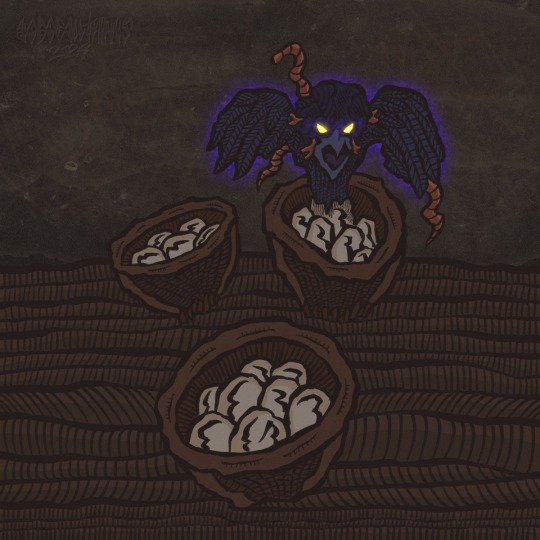
11 notes
·
View notes
Text
cowbirds exacting revenge on host birds for rejecting their eggs is so funny to me actually. dont you fucking DARE to refuse to raise my stupid shitty baby that i’m also refusing to raise
#sawyer speaking#was reading up on cowbird brood parasitism bc we have a nest on our porch that appears to be a house finch nest with one imposter among us
9 notes
·
View notes
Text
I just had a really dumb character idea
So you know how there's like mimics n stuff to which they transform/mimic and object/thing/person
I then also thought of a cuckoo bird and how it inacts brood parasitism
What if let's say this was translated to a sort of mimic thing where the mimic leaves their child to some random family and the child shifts to look like they belonged to that family although still looking more off/off-putting
The mimic child then causes "accidents" to the rest of the children in the family leaving only them in the end to have all the food and everything they need for themself to live
#oc#oc idea#oc ideas#cuckoo#brood parasitism#mimic#mimics#and then the cycle would repeat for like the next generation or whatever#what if the mimic child also theoretically copied how the other children sounded to give the parents some false hope of their old children-#being alive#idfk where that would fit into it but yeah#i would have to say this would apply also to just like normal animals in general too#like cats dogs n all that jazz#because the mimics probably wouldn't be as successful if they only went for humans#I would imagine they only go after mammals though#uhhhhmmm#anyways i hope this post wasn't like too grim or anything because this is just a small idea i had for it#i would also imagine the mimic would eat its siblings if not parents at some point once it “leaves the nest” per se
9 notes
·
View notes
Text


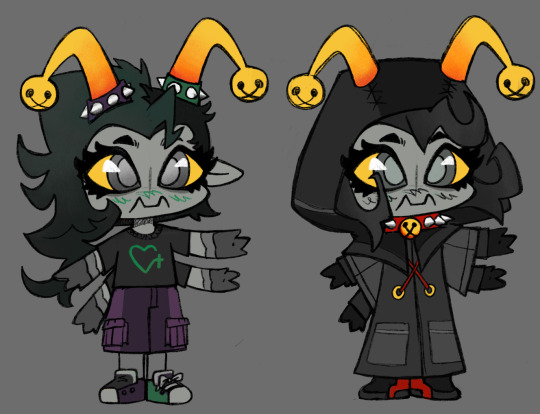
i look at you and my eyes are so so so wet like with tears tears of pure emotion and extend out my closed fist and then I open up my hand and you see her. my troll oc. the greatest oc. from 2013. I brought her back and redesigned her and im insane about her again. i begin sobbing on the ground. she’s so small. itty bitty……….
#this is melosa she is everything to me#weeping crying sobbing oh my god look at her awwwww AWWWUGHHH WEEHEHHH#sorry for not answering asks I was drawing this and buying some little bug guys who really rule.#id like to answer them soon im just a little burnt out#yeah she has an ankle monitor and hidden shock collar… little guy gets into a lot of trouble.#she’s the first jadeblooded cicada on her colony so they haven’t culled her for her antics.#the cicadas are essential to communicating with the mother grub#however by sabotage/accident she was given to a lusus for a more normal jadeblood and the nest parasite process went wrong#leading to her being rejected by her lusus : ( <im sooo edgy.#she spent a good deal of her time as a pretty young wriggler wandering around stealing from other trolls in the complex. the youngest troll#are raised in the interior layer of the planet.#she’s always been a rambler. she’s in the WALLS. she managed to break into somewhere super secret she wasn’t supposed to which got#The tracking device stuck on her. if she gets into areas she’s not supposed to be the collar might shock her.#she’s pretty miffed about the whole thing!! it doesn’t help with her exsisting issues with aggression#she likes making people mad and making people fight. just an angry wrath filled little guy#she wears the collars on her horns to stop anyone from trying to calm her down#bugstuck#buggy trolls#homestuck#homestuck oc#fantroll
98 notes
·
View notes
Text
oh I will say that one thing that really helped with college admissions discrimination resentment is turning out to be useless
if I had gone onto succeed wildly in life I would have narrativized college admissions as The Time I Almost Got Unfairly Threshed
but I burned out horribly instead and am a burden to society, so I've narrativized it as The Time When Princeton Gettier Case Rejected Me
#rambl#i think i make an honest living now but i made a lot of money off facebook for doing no or terrible work#i think i can fairly label myself a parasite#they let me get away with it so long because i'm female... thank you cultural currents. i'll take that nest egg
34 notes
·
View notes
Text
hey guys
if elquackity does replace quackity can we all agree to draw him as a cuckoo finch? thanks
#qsmp#qsmp quackity#cuckoo finches as on wikipedia: '#''The cuckoo-finch ...also known as the parasitic weaver''#The species is an obligate brood parasite laying its eggs in the nests of [other birds]#also just a fun personal hc is that elquackity's hair is fully white and he just dyes it black to look closer to quackity#also i chose cuckoo finch bc its yellow n qq is often drawn as like a yellow duck#that is all
31 notes
·
View notes
Note
I'm not sure why but these sorts of videos unnerve me with how they frame cuckoo birds.
here is the video https://www.youtube.com/watch?v=tQLCkfrlmnE
A commenter has said that the nest is likely modified by the youtuber. Videos I have ran into of this nature will often frame cuckoos as villians. I can understand their nature can make them hard to watch- they can and often endanger their nestmates and seem to act selfishly in that sense but they are still animals trying to survive. Sure, the biological parent seems like a bad parent for leaving their eggs in another bird's nest but that isn't exactly the worst type of animal parent I've heard of (there are likely far, far worse fates a baby animal could live through). And with any niche, there is an importance to their role. Could you please give your thoughts on these kinds of videos and cuckoos/parasitic birds?
@localcustard First, I don't recognize the species off the top of my head, so I can't say whether it's a species of cuckoo without doing a little more digging than I have time for right this minute (if someone recognizes it feel free to drop the species in the replies/tags/reblogs.) And bad on the videographer for moving baby birds around just to get clicks--not only is it stressful for all the birds involved, but doing so can spread diseases, causes greater chick mortality, etc., never mind spreading misinformation. This is the exact opposite of responsible nature documentation.
Brood parasitism is just another survival technique that has been evolved by cuckoos and other species (including some fish and insects!) over the millennia. It's effective enough to allow the parasites to successfully reproduce season after season, especially with the additional insurance of not having all their eggs in one basket--err, nest. Moreover, the host species still manage to survive due to a variety of adaptations; even if they do experience some mortality of their own chicks, enough survive to pass on their genes. And there are possible benefits to having a cuckoo in the nest, too!
Too many problems have arisen because we humans decided to apply our values to other beings, and then treat them accordingly. Unfortunately all that does is damage the delicate balance of the ecosystem those animals live in, especially when we decide a certain native species is "bad" and needs to be exterminated or otherwise stopped. The video's appeal is in part due to the scandal over brood parasitism and how it's supposedly
I think we need to drop "good vs bad" when it comes to nature, and replace them with "balance vs imbalance", keeping in mind what constitutes balance for each ecosystem. That includes accepting that the interplay between the cuckoo and its host birds is, in fact, balanced in its native ecosystem. We need to learn to look at these behaviors and traits in the context of the native ecosystems they evolved in, and only step in and act in cases where invasive species are using their traits to throw an ecosystem out of balance.
#localcustard#birds#brood parasitism#nest parasitism#parasites#animals#animal behavior#wildlife#birdblr#wild animals#nature#biology#ornithology
29 notes
·
View notes
Text
if god is testing me rn i would like some more information. perhaps a study guide
#potentially have a bed bug problem which if you are familiar with that. is very scary. and my job is difficult.#and i had to get my internet fixed because wasps chewed up the internet cables.#but when it got fixed it disturbed their nest and now i’m seeing more of them flying around my building#so there’s an angry bug outside my home and potentially a colony of hungry bugs feeding off my blood at night#and then the parasite of having a full time job. which has gotten increasingly stressful over the last couple months.
5 notes
·
View notes
Text
BOTD: Common Redstart

^Image credit: Jggrz
Common Redstart (Phoenicurus phoenicurus)
The nests of Common Redstarts are sometimes parasitised by Common Cuckoos, however, this appears to be somewhat beneficial to the chicks. Seeing as they nest in tree cavities, the Cuckoo chick upon hatching is unable to push the Redstart eggs out, resulting in a mixed brood. The large size of the Cuckoo affects thermoregulation in the nest, keeping the Redstart chicks warm - effectively 'brooding' them.
#common redstart#redstart#phoenicurus phoenicurus#birds#british birds#birds of the uk#common cuckoo#nest parasitism#bird breeding#bird nesting#birdwatching#bird of the day#birdoftheday#bird facts#bird fact#bird fact of the day#daily bird#bird#bird lovers#birdlovers#bird behaviour#nestlings
31 notes
·
View notes